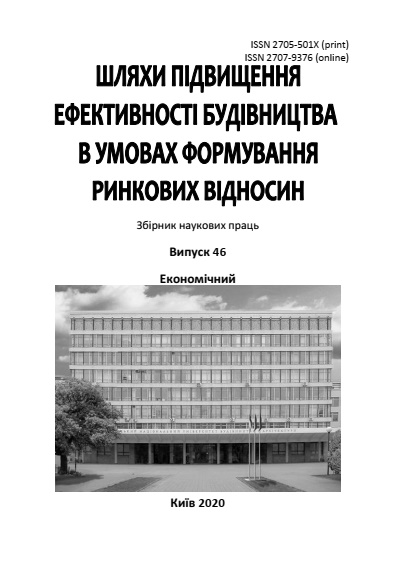Statistical and analytical aspect of the construction industry development
DOI:
https://doi.org/10.32347/2707-501x.2020.46.188-196Keywords:
anti-crisis potential, anti-crisis management, construction enterprise, threats, risks, crisis phenomenaAbstract
A study of the economic stability of construction companies at the sectoral level identified trends in changes in the structure of construction as a macroeconomic sector, the volume of income from construction activities, assets and liabilities of enterprises of various sizes. In order to study the changes in the level of sectoral competition, the dynamics of the structure of the distribution of construction enterprises by size was studied. For the final conclusion on the monopolization of the industry, in addition to the quantitative structure of enterprises, it is necessary to analyze the distribution of their income depending on the size. Therefore, accordingly, such a distribution is given not only depending on income, but also taking into account the number of employees. The average growth rate of the number of entities, their income and the number of employees according to the size of enterprises were calculated.
Trends in the development of construction companies are studied, their features, typical risks and threats, which are the low level of anti-crisis potential, which is manifested in the reduction of the number of construction companies and the number of employees. It is determined that during the analyzed period there was a steady decrease in the financial stability of enterprises of all sizes. At the same time, the role of small enterprises in the development of the construction sector grew, as, firstly, macroeconomic conditions negatively affected the performance of large enterprises, secondly, changes in the Government structural policy priorities, reforms in the direction of decentralization in general contributed to the activation of small business and private entrepreneurship. Small construction companies increase their revenues, assets, and income much more each year than large and medium-sized ones. It is due to the growth of income indicators and balance sheet items of small enterprises that the whole construction industry is growing, as the representatives of small construction business have the largest share in the trend.
The identified patterns proved the need to develop methodological approaches to increase anti-crisis potential and increase viability in a competitive environment not only for small construction companies, but also for medium and large ones.
References
Analitychni materialy Derzhstatu. https://is.gd/o3HSES
Sorokina, L. V. (2012) Doslidzhennia vplyvu makroekonomichnykh rehuliatoriv na dynamiku nahromadzhennia kapitalu u budivnytstvi Ukrainy. Aktualni problemy ekonomiky. № 6. 69-81.
Bielienkova, O.Iu., Serdiuchenko, N.B., Antropov, Yu.V. (2011) Otsinka finansovoi stiikosti malykh budivelnykh pidpryiemstv Ukrainy v 2000-2008 rokakh. Ekonomika ta derzhava, № 1. 56-60.
Stetsenko S.P., Bolila N.V. (2019) Kliuchovi determinanty formuvannia antykryzovoho potentsialu budivelnykh pidpryiemstv. Aktualni problemy ekonomiky. № 7 (217). 23-45.
Bolila, N.V. (2019) Metodychnyi pidkhid do otsiniuvannia antykryzovoho potentsialu budivelnoho pidpryiemstva. Budivelne vyrobnytstvo. № 68. 62-67.
Bolila, N.V. (2018)_ Mekhanizm formuvannia antykryzovoho potentsialu budivelnykh pidpryiemstv. Shliakhy pidvyshchennia efektyvnosti budivnytstva v umovakh formuvannia rynkovykh vidnosyn. № 37, 89-97.
Bolila, N.V. (2018) Formuvannia ekonomiko-upravlinskoho instrumentariiu antykryzovoi diahnostyky budivelnykh pidpryiemstv. Shliakhy pidvyshchennia efektyvnosti budivnytstva v umovakh formuvannia rynkovykh vidnosyn. № 37. 89-97.
Vakhovych, I.V., Molodid, O.O. (2013) Zabezpechennia ekonomichnoi stiikosti malykh budivelnykh pidpryiemstv – osnova yikh ekonomichnoi bezpeky. Shliakhy pidvyshchennia efektyvnosti budivnytstva v umovakh formuvannia rynkovykh vidnosyn: № 30. 249-255.
Bielienkova, O.Yu., Antropov, Yu.V. (2013) Ekonomichna stiikist malykh budivelnykh pidpryiemstv Ukrainy: otsinka, tendentsii, perspektyvy. Problemy ekonomiky, № 3. 51-62.
Sorokina, L. V., Hoiko, A. F. (2016) Doslidzhennia zahroz investytsiinoi bezpeky budivelnykh pidpryiemstv. Budivelne vyrobnytstvo. № 61(2). 10-21.
Sorokina, L. V., Hoiko, A. F. ets. (2017). Application of artificial intellect systems for evaluation of economical efficiency of project solutions. Economical tools for management of financial safety of construction facilities. Кyiv, Ukraine: KNUCA, 404 p.
Tugai O.A., Hryhorovskyi P.Ye., Khyzhniak V.O., Stetsenko S.P., Bielienkova O.Yu., Molodid О.S., Chernyshev D.O. Organizational and technological, economic quality control aspects in the construction industry: collective monograph. Lviv-Toruń: Liha-Pres, 2019. 136 p.
Downloads
Published
How to Cite
Issue
Section
License

This work is licensed under a Creative Commons Attribution 4.0 International License.
Authors who publish with this journal agree to the following terms:
- Authors retain copyright and grant the journal right of first publication with the work simultaneously licensed under a Creative Commons Attribution License that allows others to share the work with an acknowledgement of the work's authorship and initial publication in this journal.
- Authors are able to enter into separate, additional contractual arrangements for the non-exclusive distribution of the journal's published version of the work (e.g., post it to an institutional repository or publish it in a book), with an acknowledgement of its initial publication in this journal.
- Authors are permitted and encouraged to post their work online (e.g., in institutional repositories or on their website) prior to and during the submission process, as it can lead to productive exchanges, as well as earlier and greater citation of published work (See The Effect of Open Access).

